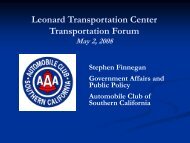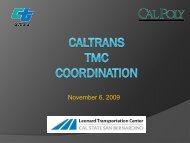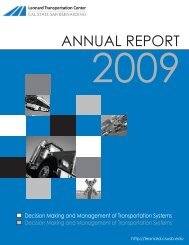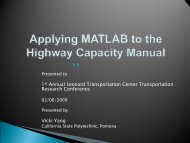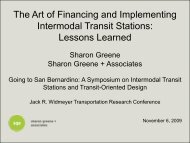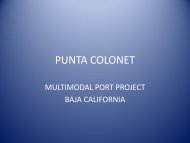Preliminaries to a Feasibility Analysis of the Maglev Proposal of The ...
Preliminaries to a Feasibility Analysis of the Maglev Proposal of The ...
Preliminaries to a Feasibility Analysis of the Maglev Proposal of The ...
Create successful ePaper yourself
Turn your PDF publications into a flip-book with our unique Google optimized e-Paper software.
applications) contains internal floors that are significantly lower (14 inches above pavement) than high<br />
floor buses. <strong>The</strong>y typically have at least two doors and a rapidly deployable ramp for wheelchair bound<br />
and o<strong>the</strong>r mobility‐impaired cus<strong>to</strong>mers.<br />
Stylized Standard Vehicle: ‐‐ Stylized standard vehicles have <strong>the</strong> features <strong>of</strong> a conventional step low‐floor<br />
vehicle but <strong>the</strong>y also incorporate slight body modifications or additions <strong>to</strong> make <strong>the</strong> body appear more<br />
modern, aerodynamic, and attractive.<br />
Conventional Articulated Vehicle: ‐‐ <strong>The</strong>se are longer, articulated vehicles that have higher passenger<br />
carrying capacity (50% more) than standard vehicles. Typically <strong>the</strong>y have partial low floors with steps<br />
and also have two or three doors.<br />
Stylized Articulated Vehicle: ‐‐ Stylized articulated vehicles are emerging in <strong>the</strong> U.S. <strong>to</strong> respond <strong>to</strong> <strong>the</strong><br />
desires <strong>of</strong> BRT communities for more modern, sleeker, and more comfortable vehicles. Step‐low floors,<br />
at least three doors with two double‐stream and quick‐deploy ramps facilitate boarding and alighting <strong>to</strong><br />
shorten s<strong>to</strong>p dwell times.<br />
Special BRT Vehicle: ‐‐ Specialized vehicles employ a modern, aerodynamic body that has a look similar<br />
<strong>to</strong> that <strong>of</strong> rail vehicles. Special axles and drivetrain configurations create a full low floor in <strong>the</strong> vehicle<br />
interior. <strong>The</strong>y also employ advanced propulsion systems and <strong>of</strong>ten include integrated ITS components<br />
and guidance systems.<br />
Operating and Maintenance Costs<br />
US experience with <strong>the</strong> introduction <strong>of</strong> BRT systems reveals typical increases in ridership. This is<br />
expected because <strong>of</strong> <strong>the</strong> usual increase in service frequency and general attractiveness <strong>of</strong> vehicles. This<br />
has translated in<strong>to</strong> improvements in operating cost efficiency for <strong>the</strong> BRT‐specific routes in terms <strong>of</strong><br />
such performance indica<strong>to</strong>rs as: (a) passengers per revenue hour (b) subsidy per passenger‐mile, and (c)<br />
subsidy per passenger. <strong>The</strong> Metro Rapid BRT line in Los Angeles, for instance, reported an increase in<br />
passengers per revenue mile from 51 <strong>to</strong> 59.7. This resulted in reduced subsidy per passenger mile from<br />
$0.20 <strong>to</strong> $0.15. <strong>The</strong> Silver Line BRT in Bos<strong>to</strong>n registered a 15% increase in riders per passenger hour.<br />
Additional details are included in Appendix 3.<br />
17



